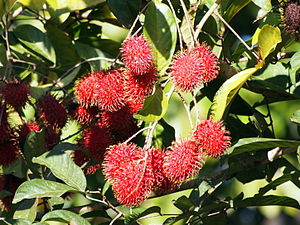Note: This is a project under development. The articles on this wiki are just being initiated and broadly incomplete. You can Help creating new pages.
Nephelium lappaceum - Rambutan
Nephelium lappaceum is a medium-sized tropical tree in the family Sapindaceae. The name also refers to the edible fruit produced by this tree. The rambutan is native to the Malay-Indonesian region and other regions of tropical Southeast Asia. It is closely related to several other edible tropical fruits including the lychee, longan, and mamoncillo.
Contents
[hide]- 1 Uses
- 2 Parts Used
- 3 Chemical Composition
- 4 Common names
- 5 Properties
- 6 Habit
- 7 Identification
- 8 List of Ayurvedic medicine in which the herb is used
- 9 Where to get the saplings
- 10 Mode of Propagation
- 11 How to plant/cultivate
- 12 Commonly seen growing in areas
- 13 Photo Gallery
- 14 References
- 15 External Links
Uses
Cancer, Hair fall, Diabetes, Common illnesses, Kidney problems, Blotches, Skin problems, Dysentery, Headaches.
Parts Used
Chemical Composition
The volatile compounds identified in rambutan fruit using GC/O are β-damascenone, (E)-4,5-epoxy-(E)-2-decenal, vanillin, (E)-2-nonenal, phenylacetic acid, cinnamic acid, ethyl 2-methylbutyrate, δ-decalactone, 3-phenylpropionic acid, 2,6-nonadienal, furaneol, 2-phenylethanol, m-cresol, maltol, heptanoic acid, nonanal, guaiacol.[1]
Common names
| Language | Common name |
|---|---|
| Kannada | |
| Hindi | |
| Malayalam | |
| Tamil | |
| Telugu | |
| Marathi | NA |
| Gujarathi | NA |
| Punjabi | NA |
| Kashmiri | NA |
| Sanskrit | |
| English | Rambutan |
Properties
Reference: Dravya - Substance, Rasa - Taste, Guna - Qualities, Veerya - Potency, Vipaka - Post-digesion effect, Karma - Pharmacological activity, Prabhava - Therepeutics.
Dravya
Rasa
Tikta (Bitter), Kashaya (Astringent)
Guna
Laghu (Light), Ruksha (Dry), Tikshna (Sharp)
Veerya
Ushna (Hot)
Vipaka
Katu (Pungent)
Karma
Kapha, Vata
Prabhava
Habit
Identification
Leaf
| Kind | Shape | Feature |
|---|---|---|
| Pinnate | Alternate | Pinnately compound without an end-leaflet |
Flower
| Type | Size | Color and composition | Stamen | More information |
|---|---|---|---|---|
| Unisexual | 0.7-2.1 mm long | Yellowish or greenish | 5 | Flowers Season is June - August |
Fruit
| Type | Size | Mass | Appearance | Seeds | More information |
|---|---|---|---|---|---|
| Simple | 7 x 5 cm | Fruit an ellipsoid to subglobular schizocarp | Many | {{{6}}} |
Other features
List of Ayurvedic medicine in which the herb is used
Where to get the saplings
Mode of Propagation
How to plant/cultivate
Seed - it has a very short viability and so needs to be sown as soon as it is extracted from the fruit. Wash the seed first to remove traces of the fruit.[3]
Commonly seen growing in areas
Dryland to swamp, Humid forests, Sandy soils.
Photo Gallery
References
External Links
- Ayurvedic Herbs known to be helpful to treat Cancer
- Ayurvedic Herbs known to be helpful to treat Hair fall
- Ayurvedic Herbs known to be helpful to treat Diabetes
- Ayurvedic Herbs known to be helpful to treat Common illnesses
- Ayurvedic Herbs known to be helpful to treat Kidney problems
- Ayurvedic Herbs known to be helpful to treat Blotches
- Ayurvedic Herbs known to be helpful to treat Skin problems
- Ayurvedic Herbs known to be helpful to treat Dysentery
- Ayurvedic Herbs known to be helpful to treat Headaches
- Herbs with Fruits used in medicine
- Herbs with Flowers used in medicine
- Herbs with common name in English
- Habit - Evergreen tree
- Index of Plants which can be propagated by Seeds
- Index of Plants which can be propagated by Cuttings
- Herbs that are commonly seen in the region of Dryland to swamp
- Herbs that are commonly seen in the region of Humid forests
- Herbs that are commonly seen in the region of Sandy soils
- Herbs
- Sapindaceae






